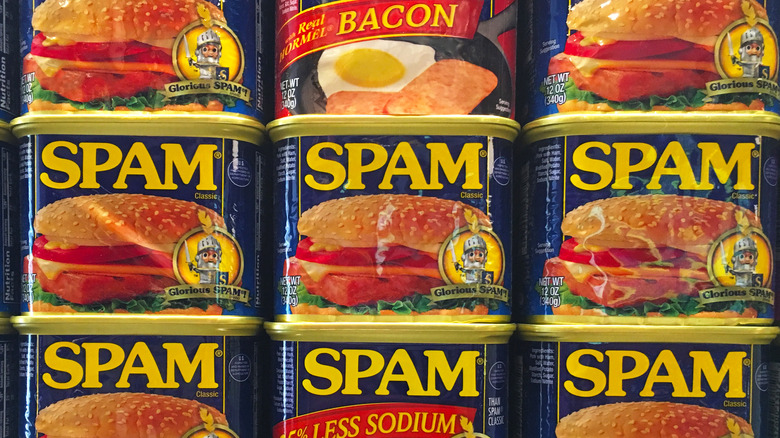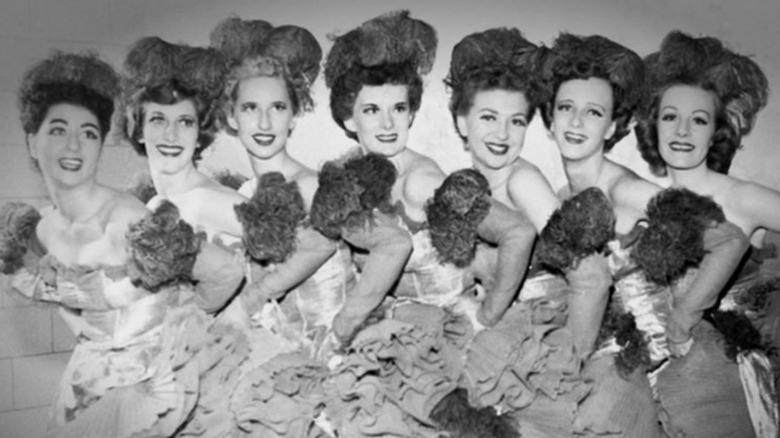Here's How Spam Became So Well Known
Spam is enormously (read: ENORMOUSLY) popular all over the world, but have you ever wondered how the canned luncheon meat became so universally loved, and the brand so recognized?
Spam was developed by Hormel Foods in 1937 as a low-cost, non-rationed protein that could be stored unrefrigerated for long periods of time. Convenience and price were alluring factors to homemakers, who began stocking their shelves with the product. During World War II, the easily-transported pork product became a primary staple for soldiers stationed abroad, and this was how it was first introduced to other countries. The demand for Spam continued to expand, too, and by 1960, more than one billion cans had been manufactured and enjoyed.
A Yelp contributor described Spam in 2015 as perhaps "America's greatest contribution to mankind". Twisted Food notes that Spam is trendily used as the starring ingredient by multiple high-end chefs, who have plated it next to foie gras, or incorporated it into their pricey tasting menus.
So, how did Spam make the enormous transformation from a budget-conscious portable meal carried in a military pack to a kitschy culinary sensation with a glimmer of class?
Hormel knew how to reach their consumers
In the earliest years, Spam basically sold itself, but Hormel's later advertising tactics have been instrumental to the product's continued success. Marketing over the last seven decades has created the opportunity for emotional connection between Spam and consumers, which PR experts say is one the best ways to promote brand attachment. A study in 2012 explained that people want to "experience [a brand] in ways beyond simply buying and using the product" (via The Conversation).
After World War II was over, the company continued to display its patriotism by forming a group of female veterans dubbed the Hormel Girls. The ladies traveled cross-country in a "caravan of white Chevys" and captivated audiences with their musical performances, while pitching Spam and other Hormel products (via JSTOR Daily). The outlet reports that they also marched in parades, made celebrity appearances, and sold Spam door-to-door. Their popularity even landed them a highly-esteemed Sunday evening radio show on a trio of national networks.
Spam's spirit still runs deep in fans' hearts
Throughout the years, Hormel has kept a thumb on the pulse of popular culture. The corporation kicked off the Great American Spam Championship in 1991, and the huge themed competition continues to this day. In 2019, the grand prize was a trip to another awesome Spam-related event — the annual Spam Jam street festival in Waikiki, Hawaii (via Hormel Foods).
In 1995, the NASCAR track sported the first Spam-sponsored race car. There's also a Spam hot-air balloon, which has been spotted floating in the New Hampshire sky.
If there is any question about Spam's current popularity, check out their official website. It's vibrant, fun, and features a section entitled "SPAM Brand Life," which is a dazzling display of animated boxes that draw you in to a world of Spam-related YouTube videos, recipes... and their gift shop. Suffice to say that there are 259 items in their selection of merchandise, ranging from a $0.25 temporary tattoo to a $250 cornhole set emblazoned with the Spam logo — and basically anything else in between. Want a Spam hoodie? It's yours. Golf bag? No problem. Neon clock? Dog leash? The world is your Spam oyster, in terms of goodies.
In addition to Spam being featured in nearly every type of cuisine, Hormel's continued attention to connecting with customers in creative ways has kept the product on the map. Spam isn't just a lunch meat — it's a fun and appealing brand!


